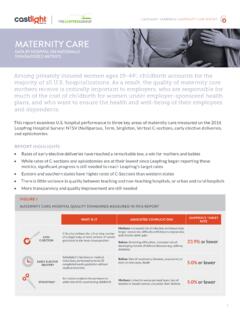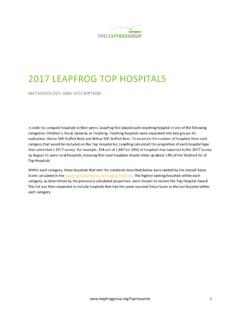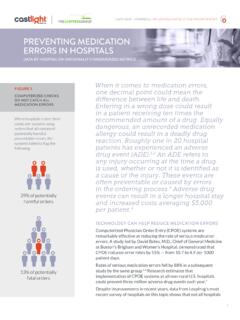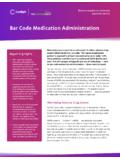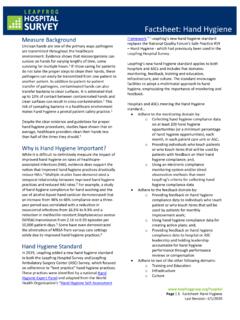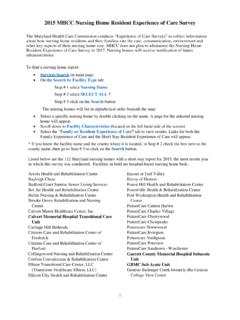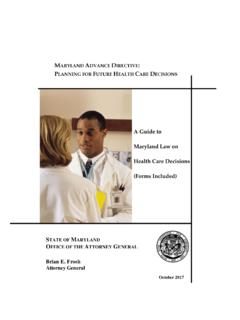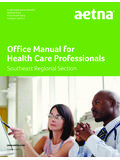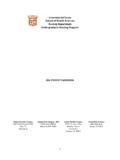Transcription of HEALTH CARE- ASSOCIATED INFECTIONS - Leapfrog
1 1 People expect a hospital to make them healthier. Unfortunately, some patients acquire an infection in the hospital that leaves them sicker than when they arrived. Every day, one out of 25 patients in hospitals contracts a HEALTH care - ASSOCIATED These patients may experience longer hospital stays, significant discomfort, and even death. Overall, these INFECTIONS cost nearly $10 billion annually, with one-fifth of this cost coming from central line- ASSOCIATED blood stream INFECTIONS (CLABSIs), and an additional $28 million coming from catheter- ASSOCIATED urinary tract INFECTIONS (CAUTIs).2 Although hospitals have made strides in preventing INFECTIONS in recent years, Leapfrog data shows that patients are still experiencing these complications too frequently. To keep patients safe, hospitals must promote adherence to guidelines for safe use of catheters and central lines, including the use of checklists and appropriate handwashing.
2 Transparency will continue to shed light on areas for improvement, and allow patients to choose the safest facilities for their PATIENTS FACE RISK OF INFECTION CLABSIs occur when a central line (a tube designed to deliver medication intravenously) is placed in a vein incorrectly and/or not kept clean allowing germs to enter the body. This type of infection is extremely dangerous, and patients who contract a CLABSI are significantly more likely to die in hospital than patients who do not contract an - Leapfrog | HEALTH care - ASSOCIATED INFECTIONS REPORTFIGURE 1 THREE QUARTERS OF HOSPITALS EXPOSE PATIENTS TO POTENTIALLY AVOIDABLE INFECTIONSHEALTH care - ASSOCIATED INFECTIONSDATA BY HOSPITAL ON NATIONALLY STANDARDIZED METRICS Percent of hospitalsCatheter- ASSOCIATED urinary tract INFECTIONS (CAUTI)Central line- ASSOCIATED blood stream INFECTIONS (CLABSI)Infection rate of rate greater than zero, but less than rate up to two times the expected rate.
3 Infection rate over two times the expected rate. Standardized infection ratio (lower is better) +1%12%7%32%67%41%25%15% 2 CASTLIGHT - Leapfrog | HEALTH care - ASSOCIATED INFECTIONS REPORTL eapfrog has set a standard that the rate of CLABSIs in intensive care units (ICUs) should be zero. In 2015, only 25% of hospitals met this standard (Figure 1). Leapfrog measures hospital infection rates in adult, pediatric, and neonatal ICUs using the standardized infection ratio (SIR), a summary statistic used by the Centers for Disease Control and Prevention (CDC) and others. The SIR is calculated as the facility s actual infection rate divided by the expected infection rate, given the types of patients the facility cares for. A lower ratio is better, and a facility with no INFECTIONS has a SIR of zero. A ratio of means that the facility s actual infection rate is the same as its expected rate.
4 The majority of hospitals (67%) had a SIR between zero and , while a small but significant minority of hospitals (8%) had a SIR above One percent of hospitals had a SIR above , indicating an infection rate over two times the expected rate. These results show marked variation in hospital CLABSI rates. Leapfrog also monitors the rate of CAUTIs in adult and pediatric intensive care units, which are among the most common types of HEALTH care - ASSOCIATED Leapfrog s standard for CAUTI is that the rate of INFECTIONS in ICUs is close to zero. Only 25% of hospitals met this standard. One third of hospitals had a CAUTI SIR greater than (Figure 2).GEOGRAPHY AFFECTS THE LIKELIHOOD OF CONTRACTING AN INFECTIONH ospitals ability to prevent these kinds of dangerous INFECTIONS varies by state. New Hampshire has on average the safest hospitals, with 67% reporting a CLABSI rate of zero (Figure 2).
5 At the other extreme, Rhode Island and Maryland showed the most urgent need to improve their infection prevention practices, with no hospitals reporting a CLABSI rate of a patient s state of residence partly determines the care they will receive, infection rates vary significantly even within communities. For example, in the metropolitan area near one major West Coast city, the CLABSI rate ranged from zero to over five times the expected rate (Figure 3). No matter where they live, however, all patients can ensure they receive the best available care by using these publicly reported results to choose a safer facility. INFECTION RATES ARE DECLINING, BUT MORE TRANSPARENCY AND QUALITY IMPROVEMENT ARE NEEDEDA decline in CLABSI rates can be partially attributed to the visibility that public reporting by Leapfrog and others brings to hospital performance. FIGURE 2IN MOST STATES, FEWER THAN HALF OF HOSPITALS MEET Leapfrog S STANDARD FOR CLABSITHE PERCENTAGE OF HOSPITALS MEETING Leapfrog S STANDARDLess than five hospitals reporting in 20150-9%10-19%20-29%30-39%40-70%Visit to view performance by hospital.
6 3 CASTLIGHT - Leapfrog | HEALTH care - ASSOCIATED INFECTIONS REPORTThe percentage of hospitals reporting a CLABSI rate of zero in Leapfrog s survey has steadily increased from of hospitals reporting in 2013, to of hospitals reporting in 2014, to of hospitals reporting in 2015. Nationwide, three-quarters of hospitals did not meet Leapfrog s standards for keeping patients safe from these INFECTIONS . All hospitals should be striving towards improving quality of care even those that are fully meeting standards. Hospitals can prevent many INFECTIONS by adhering to hand hygiene practices, using proper central line insertion techniques, and using central lines and catheters only when absolutely necessary. The persistence of these INFECTIONS in clearly shows that hospitals are not consistently following these recommended patient safety , some hospitals declined to report their data at all.
7 Government-led collection of data on HEALTH care - ASSOCIATED INFECTIONS allows HEALTH systems to submit system-level data. Leapfrog , in contrast, is the only source of infection rates by hospital ( brick and mortar facility). An increase in the number of hospitals reporting to the Leapfrog Hospital Survey would allow more providers to benchmark their own progress in achieving appropriate standards of care , and empower patients to make more informed decisions. All patients can ensure they receive the best available care by using these publicly reported results to choose a safer facility. FIGURE 3 HOSPITAL CENTRAL LINE- ASSOCIATED BLOOD STREAM INFECTION (CLABSI) RATES VARY WITHIN CITIESThe risk of a HEALTH care - ASSOCIATED infection can increase dramatically depending on the hospital a patient chooses. The highest infection rates by hospital were over five times the expected BHOSPITAL AHOSPITAL BHOSPITAL AHOSPITAL BEast CoastMidwestWest HEALTH , Spear Street, Suite 30 0 San Francisco, CA 94105Te l: 41 5.
8 8 2 0 2016 Castlight HEALTH , Inc. Castlight HEALTH is the registered trademark of Castlight HEALTH , Inc. 4 CASTLIGHT - Leapfrog | HEALTH care - ASSOCIATED INFECTIONS REPORTA bout The Leapfrog Group: Founded in 2000 by large employers and other purchasers, The Leapfrog Group is a national nonprofit organization driving a movement for giant leaps forward in the quality and safety of American HEALTH care . The flagship Leapfrog Hospital Survey collects and transparently reports hospital performance, empowering purchasers to find the highest-value care and giving consumers the lifesaving information they need to make informed decisions. Hospital Safety Score, Leapfrog s other main initiative, assigns letter grades to hospitals based on their record of patient safety, helping consumers protect themselves and their families from errors, injuries, accidents, and Castlight HEALTH : Our mission is to empower people to make the best choices for their HEALTH and to help companies make the most of their HEALTH benefits.
9 We offer a HEALTH benefits platform that engages employees to make better healthcare decisions and guide them to the right program, care , and provider. The platform also enables benefit leaders to communicate and measure their programs while driving employee engagement with targeted, relevant communications. Castlight has partnered with more than 190 customers, spanning millions of lives, to improve healthcare outcomes, lower costs, and increase benefits more information, visit and connect with us on Twitter and LinkedIn and Multistate Point-Prevalence Survey of HEALTH care - ASSOCIATED INFECTIONS , New England Journal of Medicine, March 20142. HEALTH care - ASSOCIATED INFECTIONS : A Meta-analysis of Costs and Financial Impact on the HEALTH care System, JAMA Internal Medicine, December 20133. Attributable mortality of central line ASSOCIATED bloodstream infection: systematic review and meta-analysis, Infection, February 2015 4.
10 Multistate Point-Prevalence Survey, New England Journal of Medicine, 2014 METHODSThe Leapfrog Group annually invites all adult general acute care and free-standing pediatric hospitals in the United States to voluntarily report on topics such as high-risk procedures, maternity care , hospital-acquired INFECTIONS , medication safety, nursing safety, and never events through its annual hospital survey. In 2015, a record 1,750 hospitals submitted a survey, representing 46% of hospitals nationwide. This report uses final hospital data from the 2015 Leapfrog Hospital Survey (data submitted through December 31, 2015).The Leapfrog Hospital Survey includes measures that are endorsed by the National Quality Forum (NQF) and/or aligned with those of other significant data-collection entities, including the Centers for Medicare & Medicaid Services (CMS) and The Joint Commission. Leapfrog partners with the Armstrong Institute for Patient Safety and Quality at Johns Hopkins Medicine to review survey measures and standards, and updates them annually to reflect the latest science.
